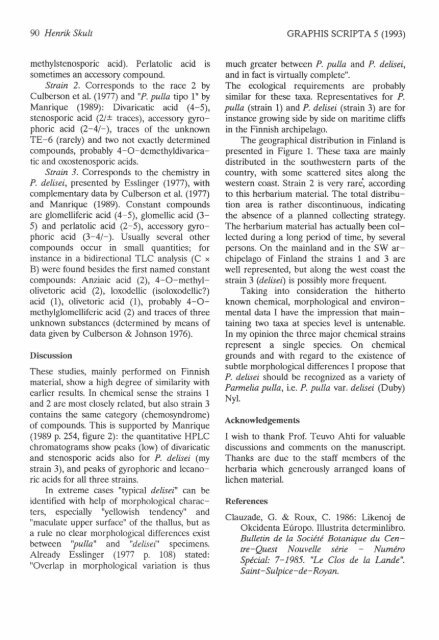GRAPHIS SCNIPTA - Universitetet i Oslo
GRAPHIS SCNIPTA - Universitetet i Oslo
GRAPHIS SCNIPTA - Universitetet i Oslo
You also want an ePaper? Increase the reach of your titles
YUMPU automatically turns print PDFs into web optimized ePapers that Google loves.
90 Henrik Skult<br />
GRAPHTS SCRTPTA s (1993)<br />
methylstenosporic acid). Perlatolic acid is<br />
sometimes an accessory compound.<br />
Strain 2. Corresponds to the race 2 by<br />
Culberson et al. (L977) and "P. pulla tipo 1" by<br />
Manrique (1989): Divaricatic acid (4-5),<br />
stenosporic acid (Llt traces), accessory gyrophoric<br />
acid (2-41-), traces of the unknown<br />
TE-6 (rarely) and two not exactly determined<br />
compounds, probably 4-O-demethyldivaricatic<br />
and oxostenosporic acids.<br />
Strain 3. Corresponds to the chemistry in<br />
P. delisei, presented by Esslinger (1977), with<br />
complementary data by Culberson et al. (1977)<br />
and Manrique (1989). Constant compounds<br />
are glomelliferic acid (4-5), glomellic acid (3-<br />
5) and perlatolic acid (2-5), accessory gyrophoric<br />
acid (3-41-). Usually several other<br />
compounds occur in small quantities; for<br />
instance in a bidirectional TLC analysis (C x<br />
B) were found besides the first named constant<br />
compounds: Anziaic acid (2), 4-O-methylolivetoric<br />
acid (2), loxodellic (isoloxodellic?)<br />
acid (1), olivetoric acid (1), probably 4-Omethylglomelliferic<br />
acid (2) and traces of three<br />
unknown substances (determined by means of<br />
data given by Culberson & Johnson 1976).<br />
Discussion<br />
These studies, mainly performed on Finnish<br />
material, show a high degree of similarity with<br />
earlier results. In chemical sense the strains 1<br />
and 2 are most closely related, but also strain 3<br />
contains the same category (chemosyndrome)<br />
of compounds. This is supported by Manrique<br />
(1989 p.254, figure 2): the quantitative HPLC<br />
chromatograms show peaks (low) of divaricatic<br />
and stenosporic acids also for P. delisei (my<br />
strain 3), and peaks of gyrophoric and lecanoric<br />
acids for all three strains.<br />
In extreme cases "typical delisei" can be<br />
identified with help of morphological characters,<br />
especially "yellowish tendency" and<br />
"maculate upper surface" of the thallus, but as<br />
a rule no clear morphological differences exist<br />
between "pulla" and "delisei" specimens.<br />
Already Esslinger (1977 p. 108) stated:<br />
"Overlap in morphological variation is thus<br />
much greater between P. pulla and P. delisei,<br />
and in fact is virtually complete".<br />
The ecological requirements are probably<br />
similar for these tara. Representatives for P.<br />
pulla (strain 1) and P. delisei (strain 3) are for<br />
instance growing side by side on maritime cliffs<br />
in the Finnish archipelago.<br />
The geographical distribution in Finland is<br />
presented in Figure 1. These ta(a are mainly<br />
distributed in the southwestern parts of the<br />
country, with some scattered sites along the<br />
western coast. Strain 2 is very rare, according<br />
to this herbarium material. The total distribution<br />
area is rather discontinuous, indicating<br />
the absence of a planned collecting strategy.<br />
The herbarium material has actually been collected<br />
during a long period of time, by several<br />
persons. On the mainland and in the SW archipelago<br />
of Finland the strains L and 3 are<br />
well represented, but along the west coast the<br />
strain 3 (delisef) is possibly more frequent.<br />
Taking into consideration the hitherto<br />
known chemical, morphological and environmental<br />
data I have the impression that maintaining<br />
two tana at species level is untenable.<br />
In my opinion the three major chemical strains<br />
represent a single species. On chemical<br />
grounds and with regard to the existence of<br />
subtle morphological differences I propose that<br />
P. delisei should be recognized as a variety of<br />
Parmelia pulla, i.e. P. pulla var. delisei (D"by)<br />
Nyl.<br />
Acknowledgements<br />
I wish to thank Prof. Teuvo Ahti for valuable<br />
discussions and comments on the manuscript.<br />
Thanks are due to the staff members of the<br />
herbaria which generously arranged loans of<br />
lichen material.<br />
Refertnces<br />
Clauzade, G. & Rorx, C. 1986: Likenoj de<br />
Okcidenta Efiropo. Illustrita determinlibro.<br />
Bulletin de la Sociitd Botanique du Centre-Quest<br />
Nouvelle sdric Numdro<br />
Spdcial: 7-1985. "Le Clos de la Lande".<br />
S aint - S ulpic e - de - Roy an.
















